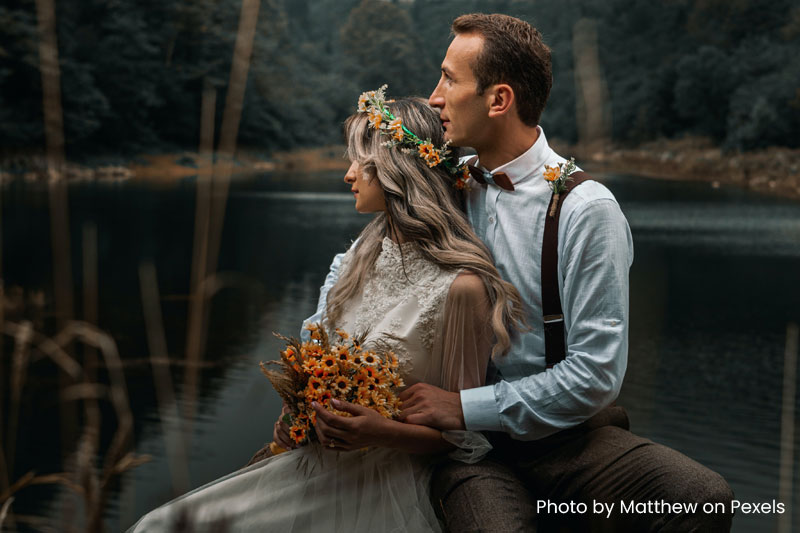Many cultures around the world have different wedding traditions, reflecting their culture, beliefs, and geographical location. Norwegian weddings are no exception. And while some traditions extend throughout the Scandinavian province, others are unique to Norway.
If you are looking to plan a Norwegian wedding or are attending a Norwegian wedding, it’s a good idea to understand some of the traditions beforehand. The following traditions are common in Norwegian weddings.
- The bridal crown: Also called a brudekrone or brudekjole, the bridal crown is an integral part of the wedding ceremony. In most instances, the brudekrone is a family heirloom passed down through the generations for each bride to wear on her special day. It often features a delicate veil made of silver to represent the Virgin Mary and the bride’s purity and delicate bangles that move freely and make music when the bride’s head moves. These bangles ward off evil spirits that may want to interfere with the bride’s happiness on her special day. The symbolism of this music is especially prevalent when the newlywed couple dance because the dangling bangles also make music and ensure nothing will spoil the happiness of the day for the bride.
- Bridal dress: Most modern Norwegian brides select a white or silver wedding dress to compliment the silver bridal crown. Bridesmaids are also present to protect the bride from evil spirits lurking around the wedding. Therefore, unlike other cultures, the bridesmaids in a Norwegian wedding often dress very similarly to the bride. This practice is meant to confuse evil spirits, so they leave the area. As an alternative to a modern dress, some Norwegian brides choose a traditional bridal dress, which is handmade using black or blue wool and embroidered with traditional Norway symbols and décor, which may vary regionally.
- The groom’s attire: If the groom wants to wear traditional wedding garb, it is called a Norwegian bunad, a woolen suit featuring a silk shirt and vest, and a pair of short silk pants. This suit is often covered with intricate designs. It is often accessorized with men’s stockings, calf-high boots or shoes, and a top coat. All men participating in the wedding ceremony will wear this traditional outfit, and many guests at the wedding and reception may also honor the tradition by donning a bunad.
- The ceremony: The church and state are one in Norway, which means couples can choose to have a ceremony in either a church or city hall, and both would be considered civil ceremonies. The wedding ceremony frequently includes the bride and groom’s parents, bridesmaids, ring bearers, and flower girls. It is common for a ceremony to include musicians, such as violinists, who lead the couple to the altar.
- The rings: As in many other countries, Norwegian couples exchange rings during the wedding ceremony. However, the rings are generally worn on the right hand rather than the left. In Norway, the right hand has a connection to the marriage oath. Rings may be as intricate or simple as the couple prefers. The roundness of the ring symbolizes the couple’s enduring love for one another.
- Barley and rye: One of the most famous Norwegian wedding traditions is to throw barley and rye grains at the couple once they have been married. The grains represent positivity; the bride’s job is to catch as many grains as possible to ensure a happy future together.
- Wedding cake: Traditional Norwegian wedding cakes include a blotkake or a Kransekake. A blotkake is a soft sponge cake filled with cream and topped with fruit and icing. A Kransekake is an almond-based ring cake stacked in layers and topped with fruit and icing. In addition to the traditional Norwegian cakes, there may also be a cheesecake or chocolate cake for guests to enjoy.
- Wedding food: A Norwegian wedding often includes a feast for the guests featuring fresh herring, smoked salmon, cabbage, potatoes, and rye bread. And since wedding receptions may go very late, a snack called nattmat is often provided for guests. The nattmat can include soups, sandwiches, sausages, meats, and drinks. During most weddings, Norwegian beer and a Scandinavian liquor called aquavit are also present. The couple will share the wedding meal together by eating with wedding spoons linked together by a chain.
- The reception: A Norwegian wedding reception allows for many wedding speeches and toasts. A toastmaster often introduces anyone who wants to tell stories or extend good wishes to the newlyweds. Anyone who wants to can make a toast, but it is usually expected that the father of the bride, bride, groom, main bridesmaid, best man, and groom’s father will make a toast. Music is also a part of any Norwegian wedding. A song called “Come to the Wedding” is generally played on an accordion while the couple leaves the church or city hall after the ceremony. Guests are expected to dance throughout the reception after the newlyweds have had their first dance as a married couple.
- Kissing: Once married, it’s customary for the bride and groom to share a kiss. However, Norwegian weddings have a lot more kissing. If the groom leaves the room during the reception, male guests may attempt to kiss the bride. Likewise, if the bride leaves the room, the groom is available for kisses from the ladies present. Additionally, guests can solicit the couple to kiss one another at any time by clinking silverware against the side of the wine glasses. Once this request has been made, the couple must stand on chairs and share a smooch!
- Fir trees: While this custom is generally observed after the wedding, a married couple will often plant fir trees on each side of the front door once they live together. These trees symbolize the children the couple plan to have during their union.
Norwegian weddings offer a glimpse into this unique culture. Like other cultures, Norwegian weddings have common traditions across most wedding ceremonies. This summary gives you a good idea of what to expect at a Norwegian wedding, although every experience will surely be as unique as the couple getting married!
Wedding Details is your comprehensive guide to all aspects of your wedding. From traditional ceremonies to questions regarding the guests, our website offers you one place to do all your research.

